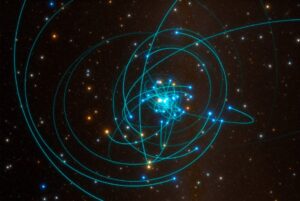New research traces the fates of stars living near the Milky Way’s central black hole

Illustration of stars orbiting close to the Milky Way’s central supermassive black hole. Credit: ESO/L. Calçada/Spaceengine.org
Despite their ancient ages, some stars orbiting the Milky Way’s central supermassive black hole appear deceptively youthful. But unlike humans, who might appear rejuvenated from a fresh round of collagen injections, these stars look young for a much darker reason.
They ate their neighbors.
This is just one of the more peculiar findings from new Northwestern University research. Using a new model, astrophysicists traced the violent journeys of 1,000 simulated stars orbiting our galaxy’s central supermassive black hole, Sagittarius A* (Sgr A*).
So densely packed with stars, the region commonly experiences brutal stellar collisions. By simulating the effects of these intense collisions, the new work finds that collision survivors can lose mass to become stripped down, low-mass stars or can merge with other stars to become massive and rejuvenated in appearance.
“The region around the central black hole is dense with stars moving at extremely high speeds,” said Northwestern’s Sanaea C. Rose, who led the research. “It’s a bit like running through an incredibly crowded subway station in New York City during rush hour. If you aren’t colliding into other people, then you are passing very closely by them. For stars, these near collisions still cause them to interact gravitationally. We wanted to explore what these collisions and interactions mean for the stellar population and characterize their outcomes.”
Rose presented this research today (April 4) at the American Physical Society’s (APS) April meeting in Sacramento, California. “Stellar Collisions in the Galactic Center” was part of the session “Particle Astrophysics and the Galactic Center.”
Rose is the Lindheimer Postdoctoral Fellow at Northwestern’s Center for Interdisciplinary Exploration and Research in Astrophysics (CIERA). She began this work as a Ph.D. candidate at UCLA, where she was advised by astrophysicist and former Northwestern postdoctoral fellow Smadar Naoz.
Continue to the full Northwestern news article.

